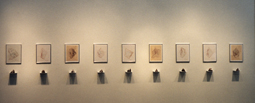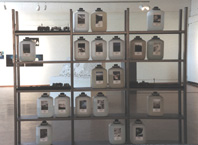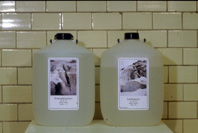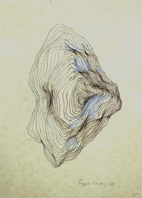World Water Archive


Water is the source of life; it's the substance that makes up the largest part of our bodies as well as the body of the earth. Fluid and in a state of constant change it can adopt any shape and condition. We depend completely on water for our existence. In both an ecological as well as a philosophical sense water controls our entire existence. World Water Archive (WWA) is an attempt to grasp this intangible substance.
Since 1995 the Swedish artist Tryggve Lundberg has been collecting water from all over the world. At present, the collection includes water from over twenty places. In his archive you'll find plastic buckets with water from locations such as Kebnekaise, Sweden's highest mountain, and the Öre River, which runs trough the little village where Lundberg grew up. WWA also contains water from cities around the globe: New York, Saigon and Venice among others. The WWA isn't made up of random samples, it's built up of water from selected spots that form different kinds of dichotomies. In WWA, water from a small peasant community in Västerbotten is displayed together with water from East River in New York. In the center and the periphery, the water is the same. Buckets from the Everest Base camp, Tibet, at the top of the world, together with water from the sea.
Naturally this work isn't complete. It's a work in progress and only the future will show what the nature of it will be in the end. Lundberg describes WWA as "a family album", with buckets instead of photos. In this sense it's a very personal work. Each of the items in this archive is like a frozen moment in time; the water's eternal circulation has been interrupted. The time, altitude, temperature and collector are carefully recorded on the label of each bucket, establishing a node in space and time. Draw a line between these points and a web or a map will be created. An imaginary map to an imagined place. Although WWA uses the aesthetic of natural science it is not to be viewed as some kind of pseudoscientific project, with the same kinds of claims as academic disciplines. The archive of water should rather be understood in the same way as the maps of mountains that also are found in Lundberg's production. These maps do not guide us to actual mountains, instead they map out small models of nonexistent mountains that have been created by the artist. These maps are in fact simulacrums for illusory mountaineering.
What complicates the interpretation of the WWA is that the artist chooses to exhibit it (most recently at Konstens Hus, in Luleå in September 2001) together with model trains (locomotives, cars and tracks). It's possible to think of these railway objects as signs connoting travelling in the same way as the WWA signifies the energy that water contains, which in Sweden is used as an important source for production of electricity (that runs the trains). Those of us who are familiar with the artist's lifelong fascination with trains and the intricate system of tracks that like a web connects remote places all over the world, interpret them in another way. For us, the combination of these disparate elements, the ever-changing water and the heavy solid train, reveal subjects of deep importance for the artist. The unity of the water and the train will also work as a point of departure for the imagination of the spectator.
* Hans T Sternudd is Art Historian and Critic
Language consultant: Marielle Nylander (Academy of Fine Art, Umeå)



 |
 |
|||
| Heterogénesis |
||||